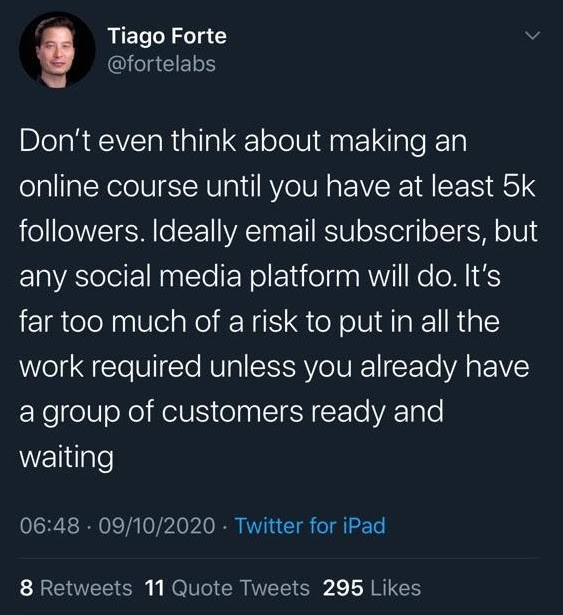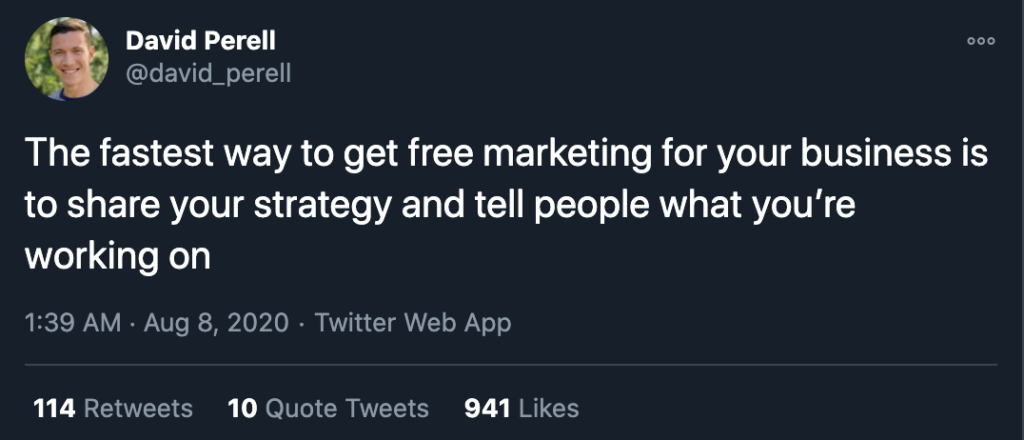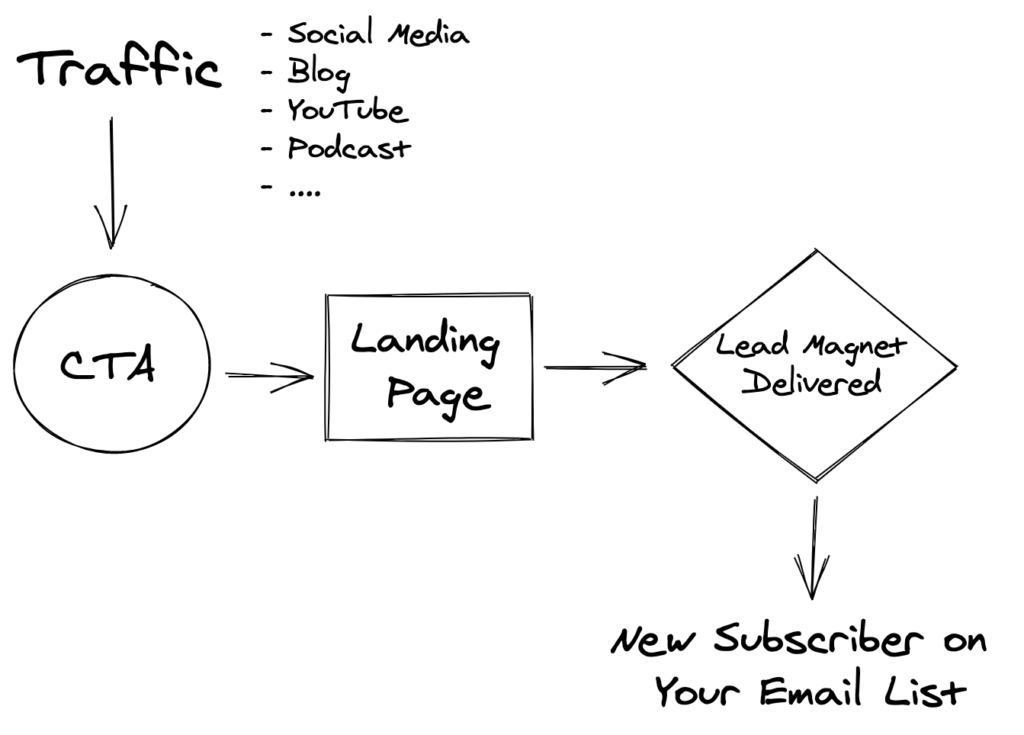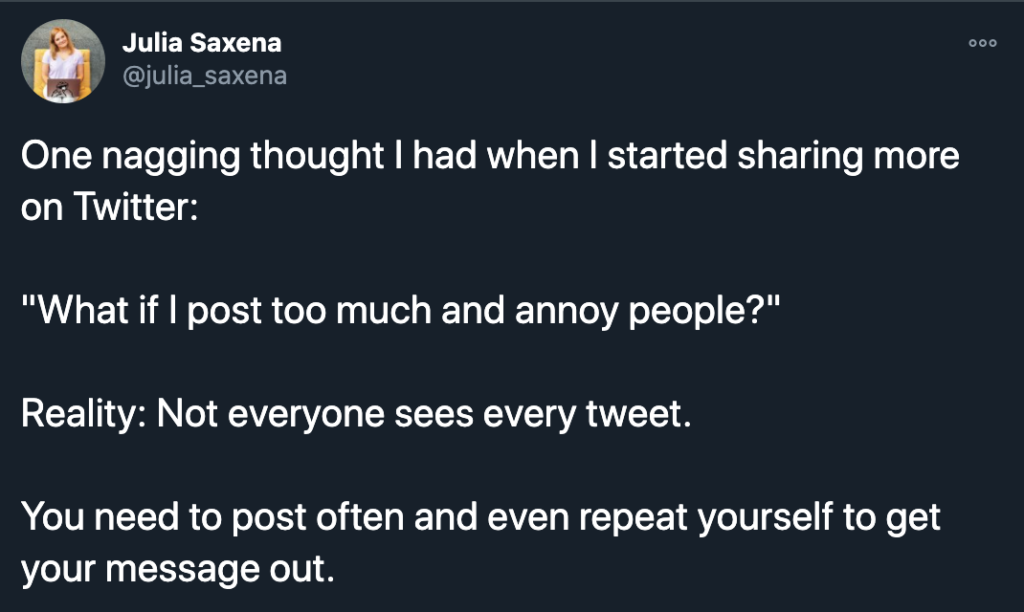How many people do you need on your email list to launch an online course? How many followers on Twitter or Facebook should you have? How many YouTube subscribers?
According to Tiago Forte, this number is 5k minimum.

While I get where Tiago is coming from, this threshold isn’t set in stone, obviously.
Minimum Viable Video’s first cohort had 20 students from an email list of around 350. Here’s my full breakdown of the launch, if you want to know more.
But, we can’t argue with the fact that a larger audience clearly increases the chances of your course generating sales.
So, how do you grow your audience? Before I get into the weeds here, we need to be crystal clear on what we want to achieve.
What’s the real goal?
Audience growth, top of the funnel (TOFU), lead generation…
Many names for the same thing: Warming up total strangers to you and what you have to offer. To go from “I’ve never heard about him/her” to “I need to know more about this.”
So how does that translate into a metric you can actively track?
It’s not the number of Twitter followers or YouTube subscribers. These don’t translate into sales.
The ultimate goal is to increase the number of people on your email list.
Yes, email – the cockroach of the internet (because it will never die).
Email is the way to go because you truly own your list. You decide when you want to get in touch with your subscribers, not an algorithm that shows your message only to a fraction of your followers.
Growing your email list and building a relationship with the people on it is one of the high leverage activities in your business.
It will take work and patience, though.
I’ve only started building my list this July and wish I had taken the initiative sooner. Then I would be much further along. But it’s never too late.
Can’t help myself but mention the obvious Chinese proverb here:
“The best time to plant a tree was 20 years ago. The second best time is now.”
Now that you know what you’re aiming for, let’s visit one principle that will make the whole audience growth thing easier.
THE principle to internalize: Build in public

David Perell said it best in this short tweet thread. Building in public is powerful. But why?
- We love to see work in progress. The messy, unpolished stuff often attracts more eyeballs than a finished piece.
- When you’re sharing what you’re doing, someone will come forward to offer help. They want to get involved.
- People feel like they’ve come along for the ride. They are invested in your journey, and most want to see you succeed.
Building in public is harder than it sounds, though. Your first inclination might be to keep it quiet until you’re absolutely sure that what you’re doing is going to work. What if you fail? Won’t that be embarrassing? What will people think?
Truth is: Everyone who has worked on something worthwhile has failed. The people you see on Twitter who’ve “made it” have failed. The important difference is that they didn’t hide when that happened. They turned the situation in their favor by sharing lessons learned, setting themselves up for success.
How does building in public look like in practice?
Basically, it’s documenting your journey of building an online course. There are three levels to what you can share with the public:
- The decisions you’re facing at any given moment, what you decide, and your reasoning behind it.
- The results you’re getting from these decisions.
- Reflections on your decisions and lessons learned.
Some great examples of this principle:
- Pat Walls documented the process of creating and launching his online course on Twitter in real time over the course of a week.
- Ali Abdaal tweeted live updates with screenshots on the launch day of his course.
- I recapped the launch of Minimum Viable Video in detail in this blog post.
Now, let’s dive into the actual steps you can take to grow your audience.
The audience growth blueprint

The funnel to get a new subscriber onto your email list is pretty straightforward, really.
Someone discovers you through social media, your blog, a podcast, or YouTube.
Then, this person clicks on a call-to-action (CTA). Might be a button or a simple link that leads them to a landing page designed to capture their name and email address in exchange for a lead magnet.
Now you’ve got a new subscriber on your list.
To make this funnel work, you need two things: a lead magnet and traffic.
Creating your lead magnet
A lead magnet is a piece of content that entices your audience to join your email list. This can take many forms, and you have tons of options when it comes to packaging your lead magnet.
One of the easiest and most impactful lead magnets to create is an email course. I’ve written in detail about how to do that.
Here are other popular formats you can experiment with:
- Ebooks – educate your audience about a specific topic
- Guides – offer step-by-step instructions
- Video series – show your audience how it’s done
- Contests and challenges – give away a price
- Cheat sheets – help them remember what’s important
- Checklists – have your audience tick all the boxes for success
- Templates and worksheets – make it easy to take action
- Whitepapers and reports – show your authority and expertise
- Webinars – engage directly with your audience on Zoom
Whatever format you decide on, consider the following questions to brainstorm ideas for your lead magnet:
- How can you solve a real problem for your audience?
- How can you get them a quick win?
- How can you make it specific and easy to digest?
- How can you show my expertise?
Looking for inspiration? Here are a few successful examples of lead magnets:
- Cam Houser offers a 6-day email course on why now is the perfect time to leverage the power of video to grow your business and accelerate your career.
- Steven Wilkinson offers a 5-day email course covering the five business finance fallacies that are limiting business owners’ potential.
- Andrew Barry offers the ebook “5 Steps for a Flawless Virtual Training,” a proven process for creating digital training solutions.
- Robbie Crabtree offers a 21-day email course to become the speaker of your dreams.
- Anne-Laure Le Cunff offers “The Beginner’s Guide to Mindframing,” an actionable 22-page handbook to better set and achieve your goals.
- Tiago Forte offers his Top 10 all-time most popular articles on productivity, creativity, note-taking, organizing, writing, personal growth, and more.
- David Perell offers a 50-day email course on writing – from finding interesting ideas to editing your essays to building an email list.
Generating traffic
To be fair, setting up a lead magnet is the easiest part. Easy because it’s completely under your control.
Traffic, on the other hand, depends on a lot of factors, which are largely out of your control. What you can do is place strategic bets and hope they’ll pay off. Here’s how to do that:
Publish pillar content
Pillar content is a long-form piece of content that discusses one of your best ideas in detail. It can be in the form of a blog post or a longer video.
This type of content shows your depth of expertise and experience in your field. It lives ideally on your website or YouTube channel to help with your SEO.
Publish one piece of pillar content per week or at least every two weeks.
Sounds like a lot of work? Yes, it is.
But the great news is that you can leverage this long-form content in so many different ways.
Coming up with ideas was the hardest part. Now, you want to make sure that you make the most out of them by repurposing your content.
Repurpose your content
The idea is to distribute your content through different mediums and platforms. With a little extra effort, you’ll give your audience a greater chance of discovering you.
Here are a few ideas for repurposing your content:
- Turn a blog post into a video or vice versa to reach your audience on another medium.
- Turn a blog post into a series of short videos.
- Create a tweet thread with the best ideas from your pillar content. Link to the main piece in the last tweet.
- Chop up your video into smaller clips to share on LinkedIn or Facebook.
- Post short ideas from your blog post on LinkedIn or Facebook.
- Take one idea, express it in a different way, and tweet it.
- Take insightful replies to your tweets and posts and turn them into their own pieces of content.
- Turn your blog post or video into an infographic.
- Create a downloadable version of your blog post.
Go on podcasts
A real “growth hack,” so to say, is leveraging someone else’s audience to grow your own. That’s basically what happens when you’re the guest on a podcast.
You’re getting exposed to new people who don’t know you yet but now have the chance to learn more about what you have to offer.
With 1.5m podcasts around in 2020, there will be at least a few shows you can add value to.
So, how do you get on a podcast?
Identify the shows that would be a great fit for what you have to share. If you can’t think of any, ask friends and peers for their favorite podcasts.
Then, start a conversation with the host. But instead of sending them a Twitter DM or email (they receive plenty of those), reach out with a personal video.
This is a smart approach for two reasons:
- You stand out! Not many people receive personalized videos.
- The host can immediately see and hear how you conduct yourself, giving them confidence that you’d be great on the show.
In your video, tell the host how they and their audience will benefit from having you on. The focus should be on what you’ll do for them, not the other way around.
If you don’t get a reply right away, follow up in a few days. A little persistence pays off.
Once you’ve been on the show and the episode has been published, don’t forget to promote it to your own audience, too.
Worried about overwhelming your audience with content?

Overwhelming and annoying your audience is highly unlikely.
But I completely understand why course creators worry about that. To you, it seems like you’re repeating the same messages over and over again. You might be getting sick of hearing yourself tell the same stories repeatedly.
For your audience, though, it’s all brand new.
Just because they hear something once doesn’t mean that they’ve immediately internalized it. They often need exposure to your messages multiple times before something “clicks” and they take action.
So, get comfortable with sounding like a broken record.






